





"Where are all my butterflies?" is the question repeated over and over on the Dave's Garden Hummingbird and Butterfly forum this summer. Theories are varied with no real answer, however there are clear steps to attracting butterflies to your garden.
(Editor's Note: This article was originally published on August 29, 2008. Your comments are welcome, but please be aware that authors of previously published articles may not be able to respond to your questions.)
A blank canvas. That is how I considered my back yard when I moved into my house nearly five years ago. A lonely daylily and a small vegetable garden were all that trimmed the yard. As a gardener of course, I thought that was fantastic. Happily I added store bought favorites and family hand-me-downs.
Today the backbone of my flower garden is a small collection of butterfly nectar plants. It's not that I know that much about butterflies, I just want to enjoy butterflies and hummingbirds. My plantings are successful and this year I looked forward to the show like previous years.
Early this season, I saw many Eastern Tiger Swallowtails in the region, including one that recently emerged from a chrysalis near the garage. The excitement was enough to interest me in raising my own butterflies. And so a visit to the Dave's Garden Hummingbird and Butterfly forum was in order. The forum did not disappoint me of course and with all the information offered I was on my way to raising butterflies.
In mid-June, I curiously searched for signs of butterflies in the garden. Where were they? Other than the early Tiger Swallowtails and some Cabbage Whites, I barely saw any butterflies. I turned to Journey North, an educational website devoted to tracking seasonal change and wildlife migration. Journey North tracks the Monarch butterfly for both spring and fall migrations. Perhaps this Monarch information could shed some light on all butterfly populations. According to Journey North, most Monarch sightings in my area were made between May10 and June 6. I did not see the first Monarch in my garden until July 8th!
Apparently I was not the only one looking for butterflies. Posts all over the Butterfly forum indicate a perceived decline in the butterfly population. No matter what the reason, seasoned gardens and butterfly watchers report a decline in local populations.
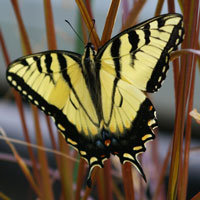
Eastern Tiger Swallowtail, Male
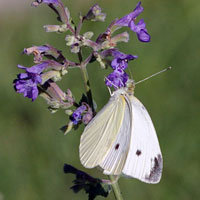
Cabbage White
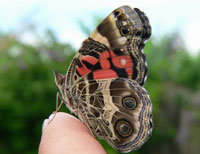
American Painted Lady from 'TexasPuddyPrint'
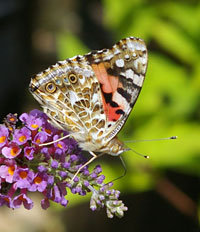
Painted Lady
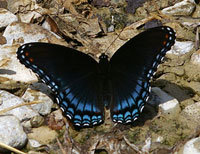
Red-spotted Purple
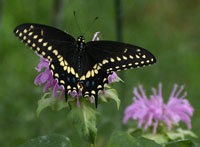
Black Swallowtail
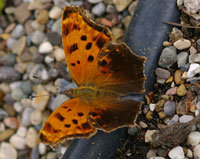
Gray Comma
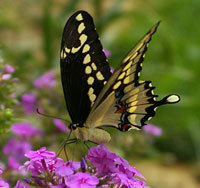
Giant Swallowtail
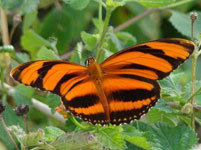
Orange-banded Butterfly (Southern Texas Only) from 'TexasPuddyPrint'
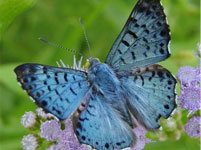
Blue Metalmark (Southern Texas Only) from 'TexasPuddyPrint'
I certainly don't have any answers for you in this article (I wish I did), but I can share with you what I learned while looking for an explanation to the low numbers early in the season.
Weather Conditions — A July 18th blog from the University of Kansas's Monarch Watch offers several answers to the questions regarding Monarch counts. The over wintering Monarch population in Mexico was slightly down and mortality rates were about normal across all regions. The spring migration into Texas was late but reproduction conditions were favorable. In May and June however, temperatures were cold and rains were plenty. Such conditions says monarchwatch.org, likely reduced the population. I can only imagine the same was true for other species.
Habitat Destruction — Many on the forum cite habitat destruction as the main cause of a general decline in butterfly populations. Large-scale conversion of woods, wetlands and meadows into developments endanger butterflies, songbirds and native host plants alike. As grasslands go by the wayside so do many native plant species that are so important for larval butterflies.
Habitat Familiarity — Some however theorize that their gardens are not well established on the butterfly rounds. I've heard this theory before regarding hummingbirds and attribute it to my own garden's inability to attract summer hummingbirds.
Each July the North American Butterfly Association (NABA) enlists Citizen Scientists to participate in a one-day Butterfly Count. With much research, the data may be interpreted in a number of ways. Some simple Internet browsing shows interesting results.
Take this year's count in Mercer County, New Jersey for instance. Observers in this area recorded record highs in some species, and their overall count for 2008 is higher than it has been in five years. The Louden Wildlife Conservancy in Virginia posts similar results, citing the spring rains for increasing nectar and host plants. This data illustrates a two-year upward trend for observers in that area. In addition, the Louden count saw their "highest number of different species: 55 in total and some of these were quite rare." The news is not always good — counts like this also confirm a continued decline in some species like the Red-Spotted Purple. The good news continues north to Canada where the Ojibway Nature Center in Windsor, Ontario. "New high counts were set for Spicebush Swallowtail, American Copper and Hickory Hairstreak." With just minimal research, it appears that the numbers in the east were good this year.
There were some typical results in the Midwest like that reported from Purdue University in Indiana, as well as in South Texas where numbers were about the same from last year, but fewer species this year. Out west the Oregon NABA chapter 2008 Count results appear less encouraging. Numbers in two locations are roughly half of what they were five years ago (2008=696; 2003=1811). To participate in a butterfly count in your area, visit NABA for local chapter information.
As one forum post mentioned, "...I don't think GARDENERS can make much of a difference." In the larger scope of things that's probably true. Unless you are an urban developer who can incorporate some changes into routine planning, you probably don't have control over large-scale habitat destruction.
But if you want to increase the local population, you might certainly make a difference. Let's talk Host Plants. Without a doubt, the best thing you can do is to plant or protect host plants for butterflies. Not every butterfly has a host plant that you can conveniently find at your local nursery though. If you are concerned about populations, find out what butterfly is in your area and then familiarize yourself with the plants on which it feeds. For example, if you are going to remove a few trees or bushes on your property for reasons other than the health of the tree, take a moment to see if they are a host plant for a species in your area (at the end of this article, you'll find a list of some common butterflies and their larval host plants).
Today I'm happy to say that the butterfly numbers in my garden are rising as were those of some of the eastern butterfly counts. Although the data does not point to any concrete answers, several factors are certain. Habitat destruction continues across North America, contributing to the demise of several host species. Rainy weather contributes both positively and negatively on populations. While spring rains slowed early generations, they also improved host plant growth, allowing for more prolific reproduction. It will be interesting to see what the October Texas populations show.
If you are planning a butterfly garden, discover what butterflies are in your area and add corresponding host plants. Don't forget the nectar plants. Choose plant varieties allowing staggered bloom times and nectar will always be available for your butterfly friends. Consider getting involved in local butterfly counts to increase your life list. Most of all have fun and enjoy the show.
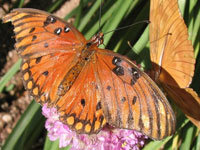
Gulf Fritillary
from 'Xenomorf'
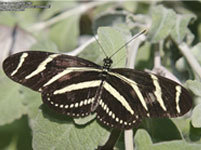
Zebra Longwing
from 'Xenomorf'
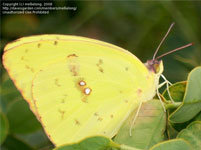
Cloudless Sulphur
from 'mellielong'
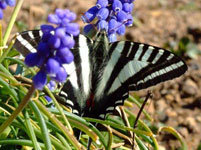
Zebra Swallowtail
from 'Magpye'
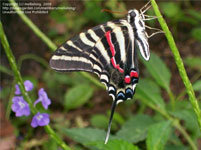
Zebra Swallowtail
from 'mellielong'
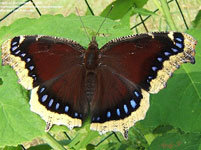
Mourning Cloak
from 'Sarahskeeper'
Thanks to Dave's Garden members who contribute to BugFiles. Images with no credit are author photographs.
BUTTERFLY
CATERPILLAR HOST PLANT
American Lady
Sunflower Family: Everlasting, Ironweed, Wormwood, Burdock
American Snout
Hackberry
Anise Swallowtail
Queen Anne's Lace
Baltimore Checkerspot
Turtlehead, False Foxglove, Plantain
Banded Orange Butterfly
Passion Vine
Black Swallowtail
Parsley, Dill, Fennel
Blue Metalmark
Albizia in the Pea Family
Clouded Sulphur
Pea Family: Clover, alfalfa and pea
Cloudless Sulphur
Cassia Species in the Pea Family
Comma, Eastern
Elm, Hops, Nettle
Comma, Gray
Gooseberry and Azalea
Comma, Green
Small Pussy Willow, Black Birch, Alder, Western Azalea and Gooseberry
Common Buckeye
Snapdragon Family, Plantain Family, Acanthas Family
Common Checkered Skipper
Mallow/Hollyhock
Common Wood-nymph
Purpletop Grass
Eastern Pygmy Blue
Annual Glassworts in the Goosefood Family
Eastern Tailed Blue
Pea Family: Clover, Alfalfa, Vetch, and Wild Pea
Falcate Orangetip
Rock Cress, Mustard
Giant Swallowtail
Citrus Family: Rue, Prickly Ash, Hop Tree
Gray Hairstreak
Mallow/Hollyhock, Pea Family (Clover, Alfalfa), Cotton
Great Spangled Fritillary
Violet Species
Gulf Fritillary
Passion-vine Species including Maypop and Running Pop
Hackberry Emperor
Hackberries and Sugarberries
Little Glassywing
Purpletop Grass
Little Yellow
Partridge Pea and Wild Sensitive Plant
Monarch
Milkweeds
Mourning Cloak
Willow, American Elm, Cottonwood, Paper Birch, Hackberry, Aspen
Orange Sulphur
Pea Family: Clover, alfalfa and pea
Orange-barred Sulphur
Cassia Species in the Pea Family
Painted Lady
Thistle, Daisy, Mallow/Hollyhock, Burdock
Pearl Crescent
Smooth-leaved True Aster
Pipevine Swallowtail
Pipevines
Polydamus Swallowtail
Pipevines
Queen
Milkweeds and Milkweed Vines
Question Mark
American and Red Elm, Nettles and False Nettle, Japanese Hop
Red Admiral
Nettle Family
Red-spotted Purple
Wild Cherry, Aspen, Poplar, Cottonwood, Oak, Hawthorn Deerberry, Birch, Willows, Basswood and Shadbush
Silver-spotted Skipper
Black Locust, Honey Locust, False Indigo
Silvery Checkerspot
Sunflower
Sleepy Orange
Cassia, Clover
Spicebush Swallowtail
Spicebush, Sassafras
Spring Azure
Dogwood, Viburnum, Blueberry, Spirea, Apple
Tawny Emperor
Hackberry
Tiger Swallowtail, Canadian
Birch, Aspen and Black Cherry
Tiger Swallowtail, Eastern
Wild Cherry, Magnolia, Basswood, Tuiip Tree, Birch, Ash, Cottonwood, Mountain Ash and Willow
Tiger Swallowtail, Western
Aspen, Cottonwood, Willows, Wild Cherry and Ash
Variegated Fritillary
Passiflora, May Apple, Violets, Purslane, Stonecrop and Moonseed
Viceroy
Willow, Poplar, Fruit Trees
White Admiral
Birch, Willow, Poplar, Honeysuckle
Zabulon Skipper
Grasses: Lovegrass, Purpletop, Bluegrass, Wheatgrass, Orchardgrass, Wildrye and Bentgrass
Zebra Longwing
Passion-vines
Zebra Swallowtail
Pawpaw
Can't find your butterfly above? Check out one of these links.
Monarch Watch List of Host Plants
The Butterfly Site — Nice list of host plants with some caterpillar images next to it.
Enchanted Learning
Connecting with Nature
Copyright © www.100flowers.win Botanic Garden All Rights Reserved